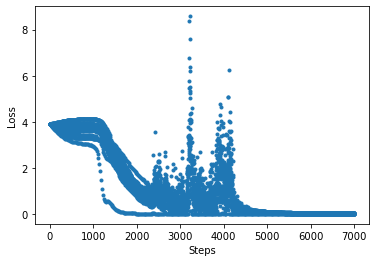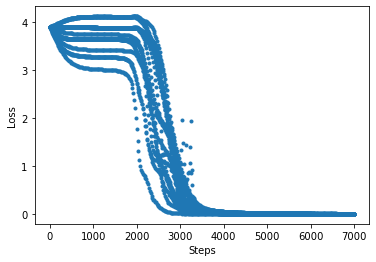The Application of Quantum Neural Network in NLP
Overview
Word embedding plays a key role in natural language processing. It embeds a high-dimension word vector to lower dimension space. When more information is added to the neural network, the training task will become more difficult. By taking advantage of the characteristics of quantum mechanics (e.g., state superposition and entanglement), a quantum neural network can process such classical information during training, thereby improving the accuracy of convergence. In the following, we will build a simple mixed quantum neural network for completing word embedding task.
Environment Preparation
Set the thread number of cpu in use.
import os
os.environ['OMP_NUM_THREADS']=1
Import relevant dependencies of the tutorial.
import numpy as np
import time
from mindquantum.core import QubitOperator
import mindspore.ops as ops
import mindspore.dataset as ds
from mindspore import nn
from mindspore.train.callback import LossMonitor
from mindspore import Model
from mindquantum.framework import MQLayer
from mindquantum.core import Hamiltonian, RX, RY, X, H
from mindquantum.core import Circuit, UN
This tutorial implements a CBOW model, which predicts a word based on its position. For example, “I love natural language processing”, this sentence can be divided by five words, which are [“I”, “love”, “natural”, “language”, “processing”]. When the selected window is 2, the task to be completed would be to predict the word “natural” given [“I”, “love”, “language”, “processing”]. In the following, we will build a quantum neural network for word embedding to deal with the this task.

Here, the encoding information of “I”, “love”, “language”, and “processing” will be encoded to the quantum circuit. This quantum circuit to be trained consists of four Ansatz circuits. At last, we measure the qubit in the
Data Pre-processing
It is necessary to form a dictionary for the setence to be processed and determine the samples according to the size of the window.
def GenerateWordDictAndSample(corpus, window=2):
all_words = corpus.split()
word_set = list(set(all_words))
word_set.sort()
word_dict = {w: i for i,w in enumerate(word_set)}
sampling = []
for index, word in enumerate(all_words[window:-window]):
around = []
for i in range(index, index + 2*window + 1):
if i != index + window:
around.append(all_words[i])
sampling.append([around,all_words[index + window]])
return word_dict, sampling
word_dict, sample = GenerateWordDictAndSample("I love natural language processing")
print(word_dict)
print('word dict size: ', len(word_dict))
print('samples: ', sample)
print('number of samples: ', len(sample))
{'I': 0, 'language': 1, 'love': 2, 'natural': 3, 'processing': 4}
word dict size: 5
samples: [[['I', 'love', 'language', 'processing'], 'natural']]
number of samples: 1
According to the above information, the size of the dictionary is 5 and it is enough to select a sample.
Encoding Ccircuitircuit
For simplification, we use the RX revolving door to construct the encoding circuit. The structure is as follows.

We apply a
def GenerateEncoderCircuit(n_qubits, prefix=''):
if len(prefix) != 0 and prefix[-1] != '_':
prefix += '_'
circ = Circuit()
for i in range(n_qubits):
circ += RX(prefix + str(i)).on(i)
return circ
GenerateEncoderCircuit(3,prefix='e')
q0: ──RX(e_0)──
q1: ──RX(e_1)──
q2: ──RX(e_2)──
For the quantum state of a
For example. given the word “love” in the above dictionary, its corresponding label is 2, represented by 010 in the binary format. We only need to set e_0, e_1, and e_2 to Evolution operator for verification.
from mindquantum.simulator import Simulator
from mindspore import context
from mindspore import Tensor
n_qubits = 3 # number of qubits of this quantum circuit
label = 2 # label need to encode
label_bin = bin(label)[-1:1:-1].ljust(n_qubits,'0') # binary form of label
label_array = np.array([int(i)*np.pi for i in label_bin]).astype(np.float32) # parameter value of encoder
encoder = GenerateEncoderCircuit(n_qubits, prefix='e') # encoder circuit
encoder_params_name = encoder.params_name # parameter names of encoder
print("Label is: ", label)
print("Binary label is: ", label_bin)
print("Parameters of encoder is: \n", np.round(label_array, 5))
print("Encoder circuit is: \n", encoder)
print("Encoder parameter names are: \n", encoder_params_name)
context.set_context(mode=context.PYNATIVE_MODE, device_target="CPU")
state = encoder.get_qs(pr=label_array)
amp = np.round(np.abs(state)**2, 3)
print("Amplitude of quantum state is: \n", amp)
print("Label in quantum state is: ", np.argmax(amp))
Label is: 2
Binary label is: 010
Parameters of encoder is:
[0. 3.14159 0. ]
Encoder circuit is:
RX(e_0|0)
RX(e_1|1)
RX(e_2|2)
Encoder parameter names are:
['e_0', 'e_1', 'e_2']
Amplitude of quantum state is:
[0. 0. 1. 0. 0. 0. 0. 0.]
Label in quantum state is: 2
Through the above verification, for the data with label 2, the position where the largest amplitude of the quantum state is finally obtained is also 2. Therefore, the obtained quantum state is exactly the encoding information of input label. We summarize the process of generating parameter values through data encoding information into the following function.
def GenerateTrainData(sample, word_dict):
n_qubits = np.int(np.ceil(np.log2(1 + max(word_dict.values()))))
data_x = []
data_y = []
for around, center in sample:
data_x.append([])
for word in around:
label = word_dict[word]
label_bin = bin(label)[-1:1:-1].ljust(n_qubits,'0')
label_array = [int(i)*np.pi for i in label_bin]
data_x[-1].extend(label_array)
data_y.append(word_dict[center])
return np.array(data_x).astype(np.float32), np.array(data_y).astype(np.int32)
GenerateTrainData(sample, word_dict)
(array([[0. , 0. , 0. , 0. , 3.1415927, 0. ,
3.1415927, 0. , 0. , 0. , 0. , 3.1415927]],
dtype=float32),
array([3], dtype=int32))
According to the above result, we merge the encoding information of these 4 input words into a longer vector for further usage of the neural network.
Ansatz Circuicircuitt
There is a variety of selections for the Ansatz circuits. We select the below quantum circuit as the Ansatz circuit. A single unit of the Ansatz circuit consists of a

The following function is defined to construct the Ansatz circuit.
def GenerateAnsatzCircuit(n_qubits, layers, prefix=''):
if len(prefix) != 0 and prefix[-1] != '_':
prefix += '_'
circ = Circuit()
for l in range(layers):
for i in range(n_qubits):
circ += RY(prefix + str(l) + '_' + str(i)).on(i)
for i in range(l % 2, n_qubits, 2):
if i < n_qubits and i + 1 < n_qubits:
circ += X.on(i + 1, i)
return circ
GenerateAnsatzCircuit(5, 2, 'a')
q0: ──RY(a_0_0)────────●────────RY(a_1_0)───────
│
q1: ──RY(a_0_1)────────X────────RY(a_1_1)────●──
│
q2: ──RY(a_0_2)────────●────────RY(a_1_2)────X──
│
q3: ──RY(a_0_3)────────X────────RY(a_1_3)────●──
│
q4: ──RY(a_0_4)────RY(a_1_4)─────────────────X──
Measurement
We treat the measurements of different qubits as the data after dimension reduction. This process is similar to qubit encoding. For example, when we want to reduce the dimension of the word vector to 5, we can process the data in the 3rd dimension as follows:
3 in the binary format is 00011.
Measure the expectation value of the Z0Z1 hams at the quantum circuit end.
The below function gives the hams to generate the data in all dimension, where n_qubits represents the number of qubits, dims represents the dimension of word embedding.
def GenerateEmbeddingHamiltonian(dims, n_qubits):
hams = []
for i in range(dims):
s = ''
for j, k in enumerate(bin(i + 1)[-1:1:-1]):
if k == '1':
s = s + 'Z' + str(j) + ' '
hams.append(Hamiltonian(QubitOperator(s)))
return hams
GenerateEmbeddingHamiltonian(5, 5)
[1.0 Z0, 1.0 Z1, 1.0 Z0 Z1, 1.0 Z2, 1.0 Z0 Z2]
Quantum Word Embedding Layer
The quantum word embedding layer combines the above-mentioned encoding quantum circuit, the quantum circuit to be trained, and the measurement of hams. num_embedding words can be embedded into a word vector with embedding_dim dimension. Here, a Hadamard door is added at the beginning of the quantum circuit. The initialization state is set to average superposition state for improving the representation ability of the quantum neural network.
In the following, we define a quantum embedding layer and it returns a quantum circuit simulation operator.
def QEmbedding(num_embedding, embedding_dim, window, layers, n_threads):
n_qubits = int(np.ceil(np.log2(num_embedding)))
hams = GenerateEmbeddingHamiltonian(embedding_dim, n_qubits)
circ = Circuit()
circ = UN(H, n_qubits)
encoder_params_name = []
ansatz_params_name = []
for w in range(2 * window):
encoder = GenerateEncoderCircuit(n_qubits, 'Encoder_' + str(w))
ansatz = GenerateAnsatzCircuit(n_qubits, layers, 'Ansatz_' + str(w))
encoder.no_grad()
circ += encoder
circ += ansatz
encoder_params_name.extend(encoder.params_name)
ansatz_params_name.extend(ansatz.params_name)
sim = Simulator('projectq', circ.n_qubits)
grad_ops = sim.get_expectation_with_grad(hams,
circ,
encoder_params_name=encoder_params_name,
ansatz_params_name=ansatz_params_name,
parallel_worker=n_threads)
net = MQLayer(grad_ops)
return net
The training model is similar to a classical network, composed by an embedded layer and two fully-connected layers. However, the embedded layer here is constructed by a quantum neural network. The following defines the quantum neural network CBOW.
class CBOW(nn.Cell):
def __init__(self, num_embedding, embedding_dim, window, layers, n_threads,
hidden_dim):
super(CBOW, self).__init__()
self.embedding = QEmbedding(num_embedding, embedding_dim, window,
layers, n_threads)
self.dense1 = nn.Dense(embedding_dim, hidden_dim)
self.dense2 = nn.Dense(hidden_dim, num_embedding)
self.relu = ops.ReLU()
def construct(self, x):
embed = self.embedding(x)
out = self.dense1(embed)
out = self.relu(out)
out = self.dense2(out)
return out
In the following, we use a longer sentence for training. Firstly, we define LossMonitorWithCollection to supervise the convergence process and record the loss.
class LossMonitorWithCollection(LossMonitor):
def __init__(self, per_print_times=1):
super(LossMonitorWithCollection, self).__init__(per_print_times)
self.loss = []
def begin(self, run_context):
self.begin_time = time.time()
def end(self, run_context):
self.end_time = time.time()
print('Total time used: {}'.format(self.end_time - self.begin_time))
def epoch_begin(self, run_context):
self.epoch_begin_time = time.time()
def epoch_end(self, run_context):
cb_params = run_context.original_args()
self.epoch_end_time = time.time()
if self._per_print_times != 0 and cb_params.cur_step_num % self._per_print_times == 0:
print('')
def step_end(self, run_context):
cb_params = run_context.original_args()
loss = cb_params.net_outputs
if isinstance(loss, (tuple, list)):
if isinstance(loss[0], Tensor) and isinstance(loss[0].asnumpy(), np.ndarray):
loss = loss[0]
if isinstance(loss, Tensor) and isinstance(loss.asnumpy(), np.ndarray):
loss = np.mean(loss.asnumpy())
cur_step_in_epoch = (cb_params.cur_step_num - 1) % cb_params.batch_num + 1
if isinstance(loss, float) and (np.isnan(loss) or np.isinf(loss)):
raise ValueError("epoch: {} step: {}. Invalid loss, terminating training.".format(
cb_params.cur_epoch_num, cur_step_in_epoch))
self.loss.append(loss)
if self._per_print_times != 0 and cb_params.cur_step_num % self._per_print_times == 0:
print("\repoch: %+3s step: %+3s time: %5.5s, loss is %5.5s" % (cb_params.cur_epoch_num, cur_step_in_epoch, time.time() - self.epoch_begin_time, loss), flush=True, end='')
Next, embed a long setence by using the quantum CBOW. Please execute this command export OMP_NUM_THREADS=4 in the terminal in advance. This command sets the thread of the quantum simulators to 4. When the number of qubits to be simulated is large, more threads can be set to improve the simulation efficiency.
import mindspore as ms
from mindspore import context
from mindspore import Tensor
context.set_context(mode=context.PYNATIVE_MODE, device_target="CPU")
corpus = """We are about to study the idea of a computational process.
Computational processes are abstract beings that inhabit computers.
As they evolve, processes manipulate other abstract things called data.
The evolution of a process is directed by a pattern of rules
called a program. People create programs to direct processes. In effect,
we conjure the spirits of the computer with our spells."""
ms.set_seed(42)
window_size = 2
embedding_dim = 10
hidden_dim = 128
word_dict, sample = GenerateWordDictAndSample(corpus, window=window_size)
train_x,train_y = GenerateTrainData(sample, word_dict)
train_loader = ds.NumpySlicesDataset({
"around": train_x,
"center": train_y
},shuffle=False).batch(3)
net = CBOW(len(word_dict), embedding_dim, window_size, 3, 4, hidden_dim)
net_loss = nn.SoftmaxCrossEntropyWithLogits(sparse=True, reduction='mean')
net_opt = nn.Momentum(net.trainable_params(), 0.01, 0.9)
loss_monitor = LossMonitorWithCollection(500)
model = Model(net, net_loss, net_opt)
model.train(350, train_loader, callbacks=[loss_monitor], dataset_sink_mode=False)
epoch: 25 step: 20 time: 0.592, loss is 3.154
epoch: 50 step: 20 time: 0.614, loss is 2.944
epoch: 75 step: 20 time: 0.572, loss is 0.224
epoch: 100 step: 20 time: 0.562, loss is 0.015
epoch: 125 step: 20 time: 0.545, loss is 0.009
epoch: 150 step: 20 time: 0.599, loss is 0.003
epoch: 175 step: 20 time: 0.586, loss is 0.002
epoch: 200 step: 20 time: 0.552, loss is 0.045
epoch: 225 step: 20 time: 0.590, loss is 0.001
epoch: 250 step: 20 time: 0.643, loss is 0.001
epoch: 275 step: 20 time: 0.562, loss is 0.001
epoch: 300 step: 20 time: 0.584, loss is 0.001
epoch: 325 step: 20 time: 0.566, loss is 0.000
epoch: 350 step: 20 time: 0.578, loss is 0.000
Total time used: 206.29734826087952
Print the loss value during convergence:
import matplotlib.pyplot as plt
plt.plot(loss_monitor.loss,'.')
plt.xlabel('Steps')
plt.ylabel('Loss')
plt.show()
The convergence figure is as follows

The method of printing the parameters of the quantum embedded layer is as follows:
net.embedding.weight.asnumpy()
array([ 1.52044818e-01, 1.71521559e-01, 2.35021308e-01, -3.95286232e-01,
-3.71680595e-03, 7.96886325e-01, -4.04954888e-02, 1.55393332e-01,
4.11805660e-02, 7.79824018e-01, 2.96543002e-01, -2.21819162e-01,
-4.67430688e-02, 4.66759771e-01, 2.75283188e-01, 1.35858059e-01,
-3.23841363e-01, -2.31937021e-01, -4.68942285e-01, -1.96520030e-01,
2.16065589e-02, 1.23866223e-01, -9.68078300e-02, 1.69127151e-01,
-8.90062153e-01, 2.56734312e-01, 8.37369189e-02, -1.15734830e-01,
-1.34410933e-01, -3.12207133e-01, -8.90189946e-01, 1.97006428e+00,
-2.49193460e-02, 2.25960299e-01, -3.90179232e-02, -3.03875893e-01,
2.02030335e-02, -7.07065910e-02, -4.81521547e-01, 5.04257262e-01,
-1.32081115e+00, 2.83502758e-01, 2.80248702e-01, 1.63375765e-01,
-6.91465080e-01, 6.82975233e-01, -2.67829001e-01, 2.29658693e-01,
2.78859794e-01, -1.04206935e-01, -5.57148576e-01, 4.41706657e-01,
-6.76973104e-01, 2.47751385e-01, -2.96468334e-03, -1.66827604e-01,
-3.47717047e-01, -9.04396921e-03, -7.69433856e-01, 4.33617719e-02,
-2.09145937e-02, -1.55236557e-01, -2.16777384e-01, -2.26556376e-01,
-6.16374731e-01, 2.05871137e-03, -3.08128931e-02, -1.63372140e-02,
1.46710426e-01, 2.31793106e-01, 4.16066934e-04, -9.28813033e-03],
dtype=float32)
Classical Word Embedding Layer
Here, we construct a classical CBOW neural network with the classical word embedding layer. This classical CBOW is compared with the quantum one.
Firstly, we construct the classical CBOW neural network and the parameters are similar to the ones in the quantum CBOW.
class CBOWClassical(nn.Cell):
def __init__(self, num_embedding, embedding_dim, window, hidden_dim):
super(CBOWClassical, self).__init__()
self.dim = 2 * window * embedding_dim
self.embedding = nn.Embedding(num_embedding, embedding_dim, True)
self.dense1 = nn.Dense(self.dim, hidden_dim)
self.dense2 = nn.Dense(hidden_dim, num_embedding)
self.relu = ops.ReLU()
self.reshape = ops.Reshape()
def construct(self, x):
embed = self.embedding(x)
embed = self.reshape(embed, (-1, self.dim))
out = self.dense1(embed)
out = self.relu(out)
out = self.dense2(out)
return out
Generate the dataset for the classical CBOW neural network.
train_x = []
train_y = []
for i in sample:
around, center = i
train_y.append(word_dict[center])
train_x.append([])
for j in around:
train_x[-1].append(word_dict[j])
train_x = np.array(train_x).astype(np.int32)
train_y = np.array(train_y).astype(np.int32)
print("train_x shape: ", train_x.shape)
print("train_y shape: ", train_y.shape)
train_x shape: (58, 4)
train_y shape: (58,)
Train the classical CBOW network.
train_loader = ds.NumpySlicesDataset({
"around": train_x,
"center": train_y
},shuffle=False).batch(3)
net = CBOWClassical(len(word_dict), embedding_dim, window_size, hidden_dim)
net_loss = nn.SoftmaxCrossEntropyWithLogits(sparse=True, reduction='mean')
net_opt = nn.Momentum(net.trainable_params(), 0.01, 0.9)
loss_monitor = LossMonitorWithCollection(500)
model = Model(net, net_loss, net_opt)
model.train(350, train_loader, callbacks=[loss_monitor], dataset_sink_mode=False)
epoch: 25 step: 20 time: 0.008, loss is 3.155
epoch: 50 step: 20 time: 0.026, loss is 3.027
epoch: 75 step: 20 time: 0.010, loss is 3.010
epoch: 100 step: 20 time: 0.009, loss is 2.955
epoch: 125 step: 20 time: 0.008, loss is 0.630
epoch: 150 step: 20 time: 0.008, loss is 0.059
epoch: 175 step: 20 time: 0.009, loss is 0.008
epoch: 200 step: 20 time: 0.008, loss is 0.003
epoch: 225 step: 20 time: 0.017, loss is 0.001
epoch: 250 step: 20 time: 0.008, loss is 0.001
epoch: 275 step: 20 time: 0.016, loss is 0.000
epoch: 300 step: 20 time: 0.008, loss is 0.000
epoch: 325 step: 20 time: 0.016, loss is 0.000
epoch: 350 step: 20 time: 0.008, loss is 0.000
Total time used: 5.06074857711792
Print the loss value during convergence:
import matplotlib.pyplot as plt
plt.plot(loss_monitor.loss,'.')
plt.xlabel('Steps')
plt.ylabel('Loss')
plt.show()
The convergence figure is as follows

According to the above result, it can be seen that the quantum word embedding model generated by the quantum simulation can complete the word embedding task perfectly. When classical computers cannot handle the large quantity of data, the quantum computers can easily deal with large data.
Reference
[1] Tomas Mikolov, Kai Chen, Greg Corrado, Jeffrey Dean. Efficient Estimation of Word Representations in Vector Space
